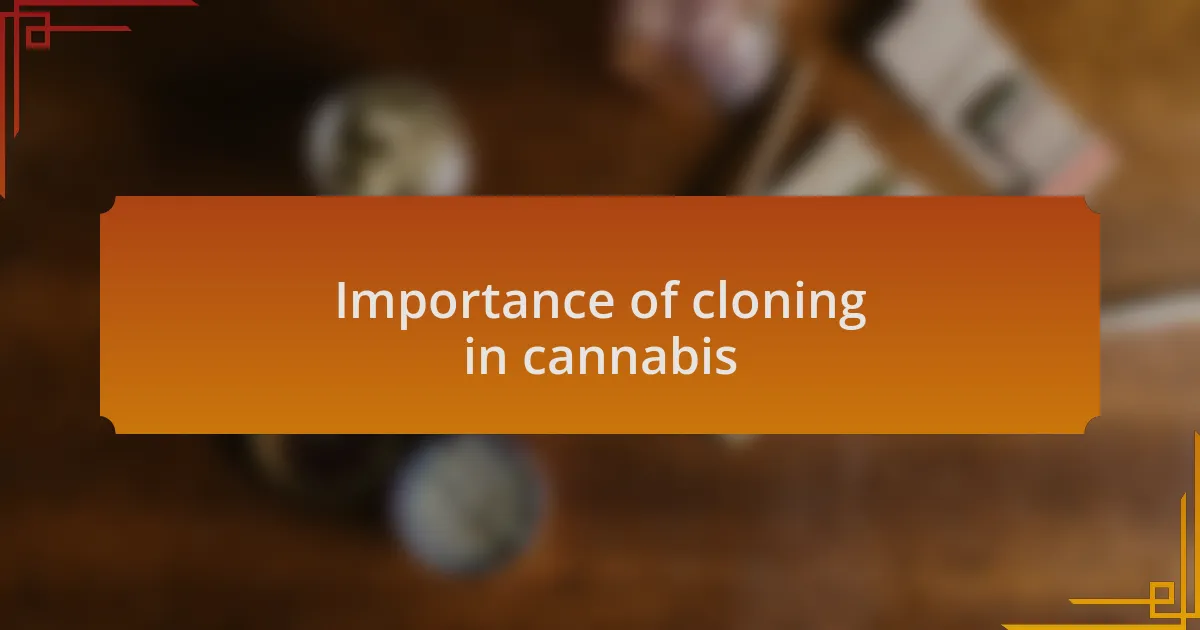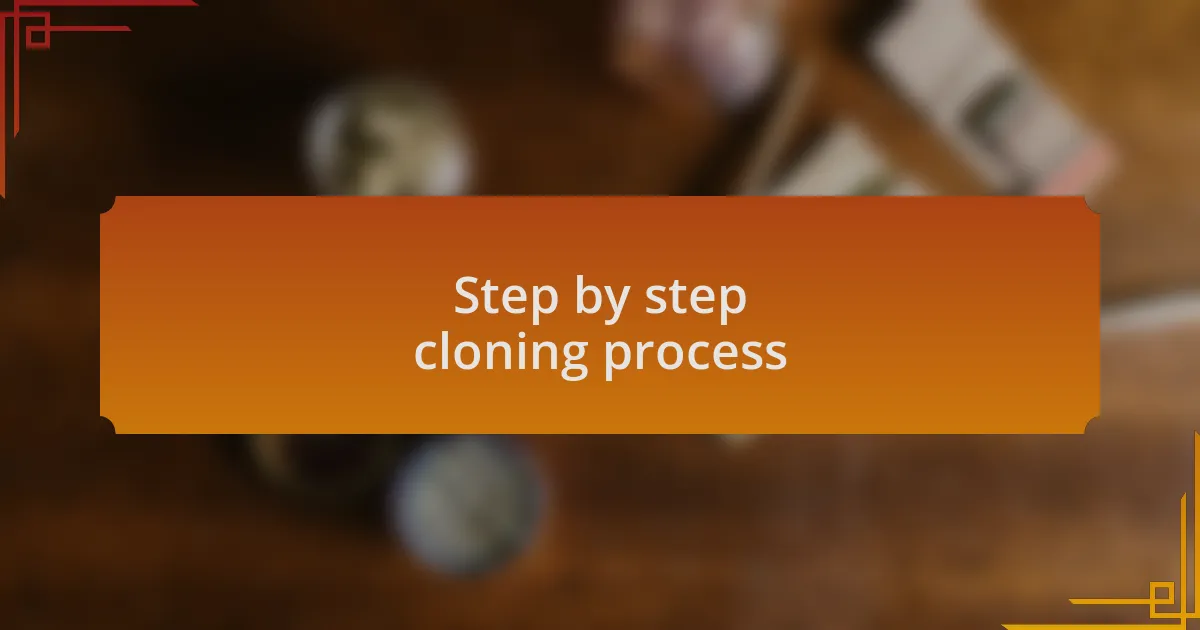Key takeaways:
- Cannabis cloning preserves the genetics of a favorite strain, ensuring consistency in flavor and potency.
- Successful cloning requires choosing healthy plants, using proper tools like sharp shears and rooting hormone, and creating optimal environmental conditions.
- Common mistakes include neglecting humidity, using improper lighting, and checking roots too early.
- Best strains for cloning include Blue Dream, Northern Lights, GSC, and various Kush strains due to their robust growth and adaptability.

Understanding cannabis cloning
Cannabis cloning is an incredible way to preserve and replicate the genetics of a plant that you’ve come to love. I’ve had moments where I stumbled upon a particular strain that had an extraordinary aroma and effect. The thought of losing that unique character if it were to go out of production was unsettling, which is why I leaned into cloning.
When you clone cannabis, you create an exact genetic copy of the parent plant, ensuring that desired traits—like flavor or potency—are reliably passed on. Isn’t it fascinating to think about how one small cutting can lead to an entire garden of your favorite strain? I remember my first cloning attempt didn’t go as planned, and it taught me the importance of technique and patience. The thrill of nurturing a clone into a mature plant is truly rewarding.
It’s also crucial to understand that not all plants are equal, and some are naturally better suited for cloning than others. Through experience, I’ve found that taking cuttings from healthy, vigorous plants often leads to greater success. Have you ever experienced the satisfaction of seeing a clone thrive? That feeling of accomplishment can be deeply fulfilling, transforming your gardening experience into something truly special.

Importance of cloning in cannabis
Cloning plays a pivotal role in maintaining consistency in cannabis cultivation. I recall a time when I tried growing a new strain from seeds, only to find that each plant varied significantly in potency and flavor. It was frustrating because I wanted to replicate that one amazing experience I had with the original strain. Cloning eliminates this variability, allowing growers to produce uniform plants with the same desirable attributes, providing a more predictable yield.
Moreover, cloning is an excellent way to maximize space and resources in your grow area. I remember having limited room but still wanting to cultivate different strains. By taking clones, I could fill my grow space more efficiently without having to wait for seeds to germinate and mature. It felt empowering to see my small corner transform into a thriving mini-ecosystem of my favorite strains from just a handful of cuttings.
Finally, there’s an emotional connection that develops through the cloning process. Each cut reminds me of the original plant and the joy it brought me. When nurturing a clone, I often reflect on the journey of the parent plant and my experiences with it. Have you ever felt like each clone has its own little story? For me, it becomes a celebration of both the individual qualities of the parent and the potential of the new plant waiting to emerge.

Best cannabis strains for cloning
When it comes to cloning, I’ve found that some strains tend to thrive far better than others. For instance, strains like Blue Dream and Northern Lights have a reputation for being particularly forgiving to novices. I remember the first time I cloned some Blue Dream cuttings; they took root effortlessly and grew into robust plants, delivering a balanced high that made the whole process rewarding.
On the other hand, GSC (Girl Scout Cookies) is another strain I often recommend for cloning. The appeal lies in its potency and rich flavor profile. I can still recall the excitement of nurturing my first GSC clone—a distinct experience where I learned that attention to detail during the cloning phase can really pay off, especially when the final product resembles the quality of the original plant. Have you had a similar experience where a clone exceeded your expectations?
Lastly, don’t overlook Kush varieties. From personal experience, I’ve found that strains like OG Kush not only clone well but also offer a diverse range of effects. I vividly remember a time when I decided to create a small Kush garden, and every clone I nurtured seemed to grow with such vigor and character. Each plant ended up being a little testament to the resilience of those genetics, showing that with the right strain, cloning can be both an art and a science.

Tools needed for cloning
When embarking on the journey of cloning, having the right tools at your disposal can make all the difference. A sharp pair of pruning shears is essential; I learned this the hard way after struggling with dull scissors that left my cuttings ragged. Clean and precise cuts encourage healthy tissue, which leads to better rooting—trust me, this small detail can significantly impact your cloning success.
Another must-have is a rooting hormone, which I swear by. I still remember the first time I applied it to my cuttings; it felt almost like giving them a little boost of encouragement. The difference was astonishing, as those clones flourished with remarkable vigor. Questions often arise about the necessity of such products, but from my experience, they provide that extra edge needed for healthy root development.
Finally, a humidity dome can be a game-changer in maintaining an ideal environment for your clones. I used to think they were optional until I lost a batch due to sudden temperature changes. With a humidity dome, I noticed my success rate skyrocketed, as it helps maintain moisture levels and provides a stable microclimate for young plants. Have you ever considered how a small tool might hold the key to thriving clones? In my experience, it makes all the difference.

Step by step cloning process
When you’re ready to start the cloning process, begin by preparing your cuttings. I like to select healthy branches with at least a few nodes, as I’ve found that these increase the likelihood of successful rooting. Trim the bottom of the cutting at a 45-degree angle—this surgical precision isn’t just for show; it maximizes the surface area for water absorption.
Next, dip the freshly cut end into your rooting hormone. The first time I did this, I felt a mix of excitement and nervousness, wondering if I was doing it right. There’s something gratifying about knowing you’ve given your clones the best possible start. Make sure to give the hormone a moment to adhere; it’s almost like setting the stage for a performance.
Now it’s time to plant your cuttings. Place them in your prepared medium, whether it’s rock wool or a soil mix. I remember when I accidentally planted too deep once; it was a learning moment. The right depth is crucial for oxygen access, so gently tap around the base to ensure a snug fit without burying them too deep. This stage is where patience comes in, as seeing those little sprouts emerge is worth the wait!

Common mistakes in cloning
One common mistake I often encountered in cloning is neglecting the humidity levels. When I first started, I underestimated how crucial a humid environment is for the cuttings. I remember leaving my clones exposed to dry air, only to find them wilting within days. It’s essential to create a mini greenhouse effect using a humidity dome or plastic wrap; this keeps the moisture levels up and helps the clones thrive.
Another pitfall is using improper lighting. I once placed my cuttings under direct, intense lights, thinking they would appreciate it, but instead, they started to droop. It became clear to me that clones need gentle light to avoid stress. A well-placed fluorescent light or LED can provide adequate brightness without overwhelming the young plants.
Lastly, being impatient with the rooting process is something many novice growers struggle with, including myself. I’ve often pulled cuttings up too soon to check for roots, but this only stunted their growth. It’s vital to give them time; I’ve learned that healthy roots aren’t just important—they’re the foundation for a successful plant!

Personal tips for successful cloning
When it comes to successful cloning, I’ve found that cleanliness is often overlooked. Initially, I would hastily cut my clones without thinking about sterilizing my tools. That led to some unexpected issues, like mold and rot. Now, I always make sure to use clean, sharp scissors and even dip them in alcohol before making any cuts. It might seem tedious, but trust me, it makes a huge difference.
I also recommend paying close attention to the medium you use for rooting. Early in my cloning journey, I tried using standard potting soil, and it just didn’t cut it. The lack of drainage caused many of my clones to suffocate. I’ve since switched to a mix that includes perlite and vermiculite, which promotes aeration and prevents overwatering. This simple change has led to a noticeable improvement in my success rate.
Another vital tip I cherish is not burdening my clones with too many nutrients right away. In my eagerness to boost growth, I once introduced a nutrient solution too soon, which shocked the new roots. These young plants don’t need much at first; instead, I let them establish themselves before adding any fertilizers. It’s a good reminder: sometimes, less really is more.